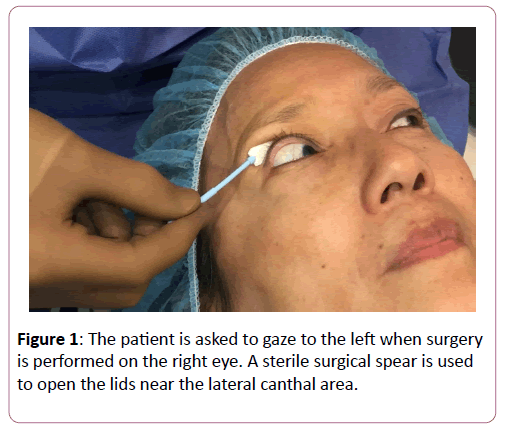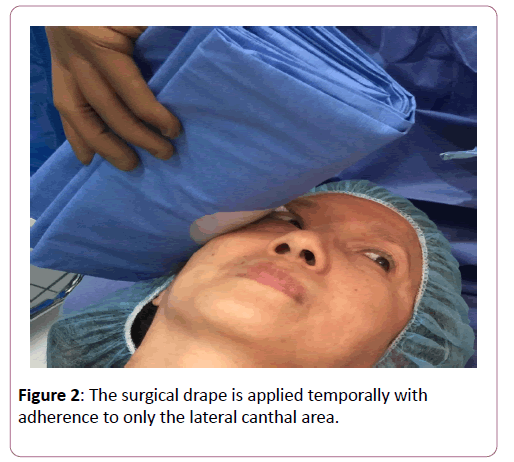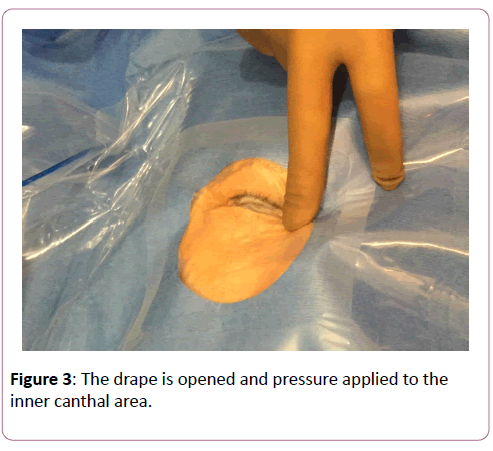Raymond Stein*
Department of Ophthalmology and Vision Sciences, Bochner Eye Institute, University of Toronto, 40 Prince Arthur Avenue, Toronto, Ontario, Canada
- *Corresponding Author:
- Raymond Stein
Medical Director, Associate Professor, Department of Ophthalmology and Vision Sciences
Bochner Eye Institute, University of Toronto, 40 Prince Arthur Avenue, Toronto, Ontario, Canada
Tel: (800) 928-9187
E-mail: RaymondMStein@gmail.com
Received date: July 31, 2017; Accepted date: August 17, 2017; Published date: August 31, 2017
Citation: Stein R (2017) Application of Eye Surgical Drape to Decrease the Risk of a Corneal Abrasion. J Eye Cataract Surg Vol. 3:35. doi: 10.21767/2471-8300.100035
Copyright: © 2017 Stein R. This is an open-access article distributed under the terms of the Creative Commons Attribution License, which permits unrestricted use, distribution, and reproduction in any medium, provided the original author and source are credited.
A corneal abrasion is a risk when applying an eye surgical drape. A new technique is discussed that decreases the risk of corneal injury. A corneal abrasion at the time of intraocular surgery may reduce visibility for the surgeon resulting in an increased risk of an intraocular complication, greater patient postoperative discomfort, and a delayed visual outcome.
Keywords
Corneal abrasion; Endophthalmitis; Surgical drape
Short Communication
Proper application of an eye surgical drape is an important step to prevent endophthalmitis at the time of intraocular surgery. Bacteria responsible for endophthalmitis commonly originate from a patient’s lids and lashes [1-3]. The goal when applying an eye surgical drape is to isolate the lids, lid margins, and eyelashes from the surgical field [4,5] to reduce the incidence of infection.
A corneal abrasion or loosening of the epithelial cells is a potential complication when applying a surgical drape. This can make the surgical procedure significantly more difficult to perform if visibility of the intraocular structures is reduced. In addition, patients with a corneal abrasion will be more uncomfortable in the early postoperative period and visual recovery can be delayed. Surgical textbooks go in to great detail about intraocular techniques but usually omit techniques of applying a surgical drape. I would like to describe a simple new technique of applying an eye surgical drape that can be successful in isolating the eye in the surgical field and result in a low incidence of a corneal epithelial defect.
It is important to recognize that the glue from a surgical drape is to adhere to the lid and periorbita area and not the cornea or conjunctiva. The clear plastic from the drape can cause a corneal abrasion if significant pressure is applied over the cornea. Patients with epithelial basement membrane dystrophy are more prone to corneal epithelial defects [6]. Rather than apply drape pressure directly over an eye, a drape can be applied temporally to decrease the risk of a corneal abrasion.
The technique is to fold the surgical eye drape in half and then instruct the patient to open their lids and gaze to the left in the case of the right eye or gaze to the right in the case of the left eye. A dry surgical spear can be used to open the lids near the lateral canthal area (Figure 1), and then the drape can be applied asserting pressure only temporally (Figure 2) and angled in line with the temporal bone.
Figure 1: The patient is asked to gaze to the left when surgery is performed on the right eye. A sterile surgical spear is used to open the lids near the lateral canthal area.
Figure 2: The surgical drape is applied temporally with adherence to only the lateral canthal area.
The drape is then opened and positioned over the eye with pressure applied to the inner canthal area and lids (Figure 3).
Figure 3: The drape is opened and pressure applied to the inner canthal area.
This technique can be successful in isolating the lids, lid margin and cilia from the surgical field with a low incidence of inducing a corneal abrasion or loosening of the corneal epithelial cells.
References
- Durand, Marlene L (2016) Endophthalmitis: An Overview. In Endophthalmitis, pp: 1-16.
- Creuzot-Garcher, Catherine, Eric Benzenine, Anne-Sophie Mariet, Aurélie de Lazzer, et al. (2016) Incidence of acute postoperative endophthalmitis after cataract surgery: a nationwide study in France from 2005 to 2014. Ophthalmology 7: 1414-1420.
- Gower EW, Keay LJ, Stare DE, Arora P, Cassard SD, et al. (2015) Characteristics of endophthalmitis after cataract surgery in the United States Medicare population. Ophthalmology 122: 1625-1632.
- Krzewinski, Henrietta K (1976) Folded surgical drape U.S. Patent No. 3,952,738.
- Bailey Jr, Paul F (1993) Ophthalmologic drape and method. U.S. Patent No. 5,213,114.
- Reidy JJ, Paulus MP, Gona S (2000) Recurrent erosions of the cornea: epidemiology and treatment. Cornea 19: 767-771.




